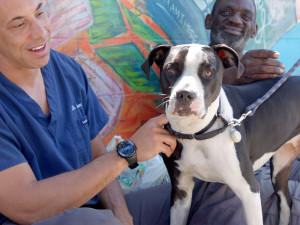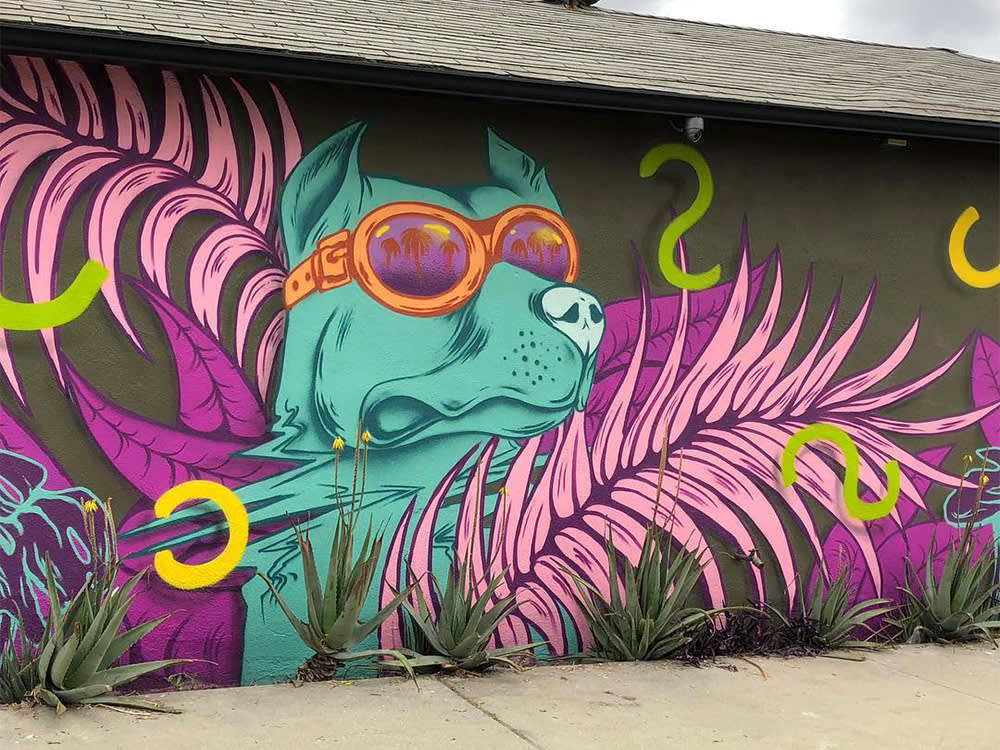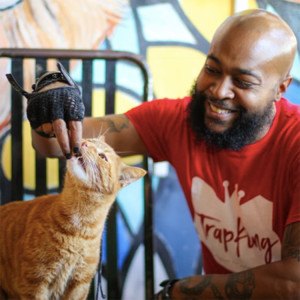Downtown Dog Rescue is Helping Dogs Stay Out of Shelters
Working to keep low-income and homeless people and their pets together.
She has been threatened with guns and knives. Dogs she’s saved have killed one another. Prisons and shelters steal her clients. But Lori Weise “can’t wait to see what happens tomorrow.” The co-founder of Downtown Dog Rescueopens in new tab (DDR), a nonprofit affiliate of Friends for Animals in North Hollywood, believes that good things happen in bad neighborhoods every day.
With her “get things done” approach, Weise is helping to make a difference by bringing free services to communities the city ignores. One example is her block party-style spay/neuter events, hosted on the rough and tumble streets of Compton and Watts. South Central Dog Club is another. Evidence that her work is being noticed arrives in the form of grants, awards, and a stream of glowing letters, like one she received from Apple Valley Animal Control after she paid the $90 fee a woman couldn’t afford to claim her old Shepherd, who was facing euthanasia.
Trick question: All dogs are perfect! But find out which type is the best fit for you.
Broken Dreams, Broken Lives
The idea of rescuing dogs conjures up images of wagging tails and grateful kisses. But Weise has another story to tell. It’s about dogs and people living in Third World conditions in the seventh-richest city in the world. It’s about a place where people’s belongings fit into a shopping cart—a place where tails don’t always wag. Why would Weise, a soft-spoken, college-educated furniture factory manager, choose this beat? Why—in a city that worships appearances—would she shun makeup, jewelry and loose hair (she’s already given up TV and movies since she says that what she sees on the streets is more than she can deal with visually)? For the dogs, of course. Downtown Dog Rescue, at its inception, was the only organization in California founded to assist the most forgotten sector of the American pet world: homeless dog parents.
It began in 1996, when Weise and Richard Tuttlemondo, managers at Modernica furniture factory in downtown Los Angeles, decided to do something about the suffering dogs that swarmed the streets. Their plan to spay and release the females led them to the nearby Skid Row—a 50-square-block urban dead zone where the sun rises each day to a congregation of thousands living in dreadful conditions.
They ventured into these homeless encampments looking to capture dogs but learned they would first have to capture the hearts and minds of the people who lived there. Many of the “strays,” they discovered, had owners.
How much do you spend on your pet per year?
A Plan to Rescue Dogs from the Streets
Iron Head, an older Pit Bull, never strayed far from New Orleans-born Benny Josephs. Josephs was Weise and Tuttlemondo’s first link to Skid Row’s dog-people. He had found Iron Head with a burn mark on his head, as though he’d been hit with a frying pan. At first, he told them he was afraid of the big black dog, but soon they were sharing a cardboard “double-decker”; Josephs slept on the upper deck and Iron Head rested below—like a bunk bed.
As Weise gradually learned, the life of a “road dog” is a journey filled with hazards. Road dogs trade the anguish of confinement for the dangers of the street. They may pay for their freedom with their lives, Weise says, but none of these dogs would survive LA’s overcrowded shelters.
For the first seven years, Tuttlemondo and Weise confined their efforts to Skid Row, where they encountered the many problems homeless pet parents face. Necessities were scarce. Dogs couldn’t be licensed if their people didn’t have an address. Homeless shelters and Section 8 housing don’t accept pets. Disease was rampant. Some dogs were abused, or kept solely to aid panhandlers. “The situations were just slightly above awful, ” Weise says, admitting that initially, they wanted to take the dogs away from these conditions. But, considering that there were too many dogs, that most were highly unadoptable and that the people objected, separating dogs from homeless people who’d been caring for them didn’t feel right.
Instead, Tuttlemondo and Weise brought services to those who needed them. They delivered food, took dogs to the vet, bought some from abusive owners and housed them in kennels that Tuttlemondo built behind Modernica. They solved the licensing problem by providing their business address and paid the fees to license more than 300 dogs. While they continue to work with the homeless, there are far fewer Skid Row dogs, thanks to their successful spay/neuter campaign. Gradually, Downtown Dog Rescue’s focus has shifted to low-income owners in Watts, Compton and South Central LA.
Risky Business
One day in 2003, as Weise was walking by a business near Modernica, someone called out that he had found a dog for her. He led her to a beautiful blue Pit Bull chained in the yard. By now, Weise was very familiar with her canine client base. Most were Bully breeds, raised on street survival. Some were trained fighters. All were unpredictable.
She called Tuttlemondo, and together they walked “Blue” to the factory, where their dog Sinbad greeted him. In a flash, Blue went from calm to crazed, lunging so violently at Sinbad that they knew he would kill him. Jumping in, Weise and Tuttlemondo wrestled Blue into a kennel. Locked inside, he exploded, spinning and rocking the frame. The powerful dog then tore a hole in the military-strength kennel, nearly ripping off the door. Shaken, they rushed him to a vet for boarding, and wondered if it was time to quit.
Weise and Tuttlemondo had a kennel license and nonprofit status. But a huge challenge remained: The dogs were uncontrollable. And unadoptable. There had been fights to the death. Their decision to keep the dogs separated only deepened their distress. Weise was plagued by fears of fights and of failure. Then a law was passed prohibiting the homeless from sleeping on the streets. As their pet parents were arrested or forced to move on, more dogs were in need of rescue.
One afternoon, a friend convinced Weise to take Blue to meet “dog whisperer” Brandon Fouche of Canine Communications. Arriving at his South Central LA facility, she was surprised to see a pack of Bully breeds playing together. Fouche, known for whisking uncontrollable dogs off to the mountains and returning them transformed, asked her what her dog knew. “Sit, down, heel,” she answered.
According to data compiled by rescue organizations, aggression is among the 10 reasons dogs are abandoned in Los Angeles. Come back in two weeks, he said, and Blue will be running with the others. Weise didn’t believe him. Still, when she saw Tuttlemondo, she told him how inspired she was by the meeting with Fouche. Perhaps it was a turning point.
Two weeks later when she arrived to retrieve Blue, there he was, romping with the pack. “I had tears in my eyes,” Weise recalls. They brought more dogs to Fouche for rehabilitation. His methods, which focus on the dog’s nature as a pack animal who craves order, help poorly socialized dogs “learn to judge their own aggression,” Weise says.
One day, Fouche turned down a dog. “You’re gonna do this one yourself,” he told her. So Weise started taking the incorrigible Lulu everywhere. Socialization “boot camp” lasted two solid weeks. Then, before releasing her into a group with a few of the calmer dogs, she walked her up and down the stairs of the three-story warehouse until the potbellied Pit nearly collapsed. It worked. One fight-free encounter led to another. Soon after her first successful rehabilitation, she says, “I began to implement programs no one had seen before.”
The Power of the Pack
She says that play is expressive and an outlet for normal aggression within the pack. When natural behaviors are suppressed, dogs become stressed, often acting out with greater aggression.“The trick is judging the limit and what all the barks and growls mean.”
Unlike rescue facilities, she argues, shelters resemble prisons. The structure isolates dogs, reinforcing their problems and lowering their chances of adoption. She also notes that dogs with low-income pet parents are more often abandoned because their people are more affected by fines and fees. Weise says that vets in poor neighborhoods have been known to charge very high rates and neglect to tell eligible people about free city services. In other cases, people have actually chosen homelessness over housing that refuses pets.
When people call Downtown Dog Rescue intending to relinquish a dog, volunteers first asks, “What will it take for you to keep your dog?” The many answers to that question have helped inform their unique programs. While the usual menu of services is offered, there is nothing usual about distributing thousands of hip-hop flyers on gang turf that beckon homies to “Pimp Your Pit” and “Get Fixed or Die Tryin’.” Or hosting block party–style events in places like Watts or Compton; a city only ten square miles in size that’s home to over 57 active gangs. “People told me it would be a disaster,” Weise says of the first large-scale spay/ neuter event in 2002—“and it turned out great.”
Unlikely Allies
Rosalie Bardwell, a steely Compton volunteer, says that while they are able to manage the crowds, neighborhood reception is sometimes chilly. The notoriously tough city is even less welcoming to outsiders. Weise often hears comments suggesting she doesn’t belong in a certain neighborhood. “Dog people are dog people,” is her standard reply. She admits that in some cases—like the time she unwittingly walked in on a drug deal—fear has forced her to leave dogs “in terrible situations.” To deal with these circumstances, she relies on volunteers— “street soldiers” who know the community. She’s also learned to practice the “buy-in,” which simply means paying someone for help or information (like distributing flyers). Low-income volunteers attend weekly adoptions, tell her about dogs in trouble, and talk each other into spaying and neutering. The Humane Society’s Chicago dog-fighting division approached Weise, wanting to duplicate her urban programs in other cities with a “Pit Bull problem.” Her advice to rescue groups seeking street credibility: “Realize that you are the one who needs the education. Otherwise, there will always be the wall.”
The wall is thick with language, cultural and religious differences, in addition to issues of mental illness. Some pet parents don’t “believe” in spaying. Others take pride in their dog’s aggression. Weise favors outreach over preachy reform. “Through the dogs, I can promote social change.” She bets her own money on it through housing deposits, rides to appointments —even paying the salaries of homeless people she employs at Modernica.
Finding Safe Havens
Some of Weise’s clients rehabilitate dogs. They do so even when the comfort they bring to a dog’s life is missing from their own. Jo Barker, who lives in South Central, has recently undertaken “back-to-back rescues” and facilitated her first adoption — a family who took in a sweet Pit Bull that Barker rescued from a violent neighbor. Barker doesn�’t go looking for them. “The good dogs always find me,” she says. And they are never just dogs. They are the “coffee hound,” the “pogo stick,” the “Dachshund who saved himself...”
But in 2003, Barker, then 42, had no home. “My whole family’s world came crashing down,” is how she describes her pitch into homelessness. Her son moved in with his girlfriend and Barker’s four dogs stayed in the yard of an acquaintance.“ They were the first thing I saw in the morning and the last thing I saw at night before going back to the shelters,” she says. She lived this way for three years, moving from shelter to motel, only able to keep two of her dogs.
After the experience, she began a fight to help residents keep their dogs. She dedicated herself to legal research, unearthing documents showing that a homeless person’s dog can be considered an “emotional support” service animal under the Fair Housing Act. Such dogs are permitted in Section 8 and other federally assisted housing programs. The sticking point was finding landlords who would willingly accept them. The battle between staff and dog owners raged for months until the Los Angeles Homeless Services Authority was called in. After three months of contention, an agreement was finally reached. Residents would not have to choose between keeping their dogs or a roof over their heads.
With the help of Downtown Dog Rescue, Barker’s street dog, Boxer, is learning trust and stability—no easy task, considering his rough beginning. But helping pups living in one of LA’s toughest neighborhoods can be life-saving. “My dog is my bodyguard and house protector,” she says as she points to the distinct coloring on his shoulders — in the shape of angel wings.









